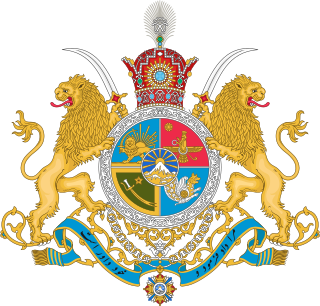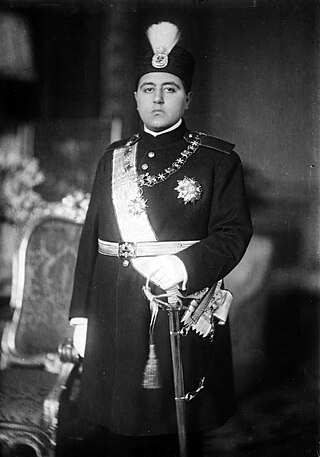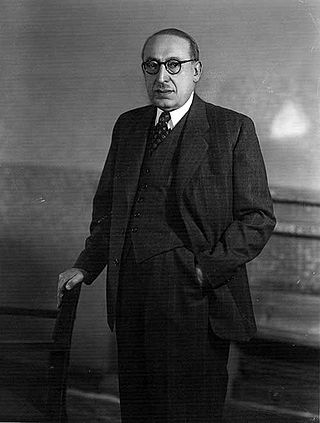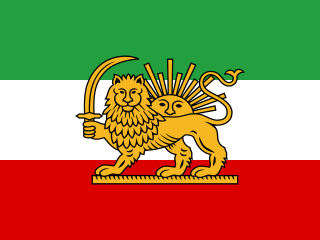
Reza Shah Pahlavi was an Iranian military officer and the founder of the Pahlavi dynasty. As a politician, he previously served as minister of war and prime minister of Qajar Iran and subsequently reigned as Shah of Pahlavi Iran from 1925 until he was forced to abdicate after the Anglo-Soviet invasion of Iran in 1941. He was succeeded by his eldest son, Mohammad Reza Shah. A moderniser, Reza Shah clashed with the Shia clergy and introduced social, economic, and political reforms during his reign, ultimately laying the foundations of the modern Iranian state. Therefore, he is regarded by many as the founder of modern Iran.

The Pahlavi dynasty was the last Iranian royal dynasty that ruled for roughly 53 years between 1925 and 1979. The dynasty was founded by Reza Shah Pahlavi, a non-aristocratic Mazanderani soldier in modern times, who took on the name of the Pahlavi language spoken in the pre-Islamic Sasanian Empire to strengthen his nationalist credentials.

The Qajar dynasty was an Iranian royal dynasty founded by Mohammad Khan of the Qoyunlu clan of the Turkoman Qajar tribe.

Ahmad Shah Qajar was the shah of Iran (Persia) from 16 July 1909 to 15 December 1925, and the last ruling member of the Qajar dynasty.

The prime minister of Iran was a political post that had existed in Iran (Persia) during much of the 20th century. It began in 1906 during the Qajar dynasty and into the start of the Pahlavi dynasty in 1923 and into the 1979 Iranian Revolution before being abolished in 1989.

Ahmad Qavam, also known as Qavam os-Saltaneh, was an Iranian politician who served as Prime Minister of Iran five times.

Prince Firouz Nosrat-ed-Dowleh III, GCMG (1889–1937) was the eldest son of Prince Abdol-Hossein Farmanfarma and Princess Ezzat-ed-Dowleh Qajar. He was born in 1889 and died in April 1937. He was the grandson of his namesake, Nosrat Dowleh Firouz Mirza, and of Mozaffar ad-Din Shah Qajar through his mother, Princess Ezzat-Dowleh.

Iranian nationalism is nationalism among the people of Iran and individuals whose national identity is Iranian. Iranian nationalism consists of political and social movements and sentiments prompted by a love for Iranian culture, Iranian languages and history, and a sense of pride in Iran and Iranian people. While national consciousness in Iran can be traced back centuries, nationalism has been a predominant determinant of Iranian attitudes mainly since the 20th century.

The first Iranian legislative election held in July 1906 after Iranian Constitutional Revolution by a sentence from Mozaffar ad-Din Shah Qajar.

Parliamentary elections were held for the second time in Persia in 1909. The new Parliament convened on 19 November. The majority of the parliament was held by a some 53-seats coalition pioneered by Moderate Socialists Party.

Gholam Reza Pahlavi was an Iranian prince and a member of the Pahlavi dynasty, as the son of Reza Shah and half-brother of Mohammad Reza Pahlavi, the last Shah of Iran.

The Marble Palace is a historic building and former royal residence in Tehran, Iran. It is located in the city centre, but the location was a quiet quarter of Tehran when the palace was erected.

The Imperial State of Iran, officially known in English as the Imperial State of Persia until 1935, and commonly referred to as Pahlavi Iran, was the Iranian state under the rule of the Pahlavi dynasty. The Pahlavi dynasty was created in 1925 and lasted until 1979, when it was ousted as part of the Islamic Revolution, which ended the Iranian monarchy and established the current Islamic Republic of Iran.

The Guarded Domains of Iran, alternatively the Sublime State of Iran and commonly called Qajar Iran, Qajar Persia or the Qajar Empire, was the Iranian state under the rule of the Qajar dynasty, which was of Turkic origin, specifically from the Qajar tribe, from 1789 to 1925. The Qajar family played a pivotal role in the Unification of Iran (1779–1796), deposing Lotf 'Ali Khan, the last Shah of the Zand dynasty, and re-asserted Iranian sovereignty over large parts of the Caucasus. In 1796, Agha Mohammad Khan Qajar seized Mashhad with ease, putting an end to the Afsharid dynasty. He was formally crowned as Shah after his punitive campaign against Iran's Georgian subjects.
Moderate Socialists or simply Moderates Party, was a political party in Qajari Persia and one of the two major parties of the constitutional period alongside its parliamentary rival Social Democratic Party–Democrat Party. It was Iran's first right-wing political party.
The Democrat Party was a social democratic political party in Qajari Persia, during the constitutional period. It was one of two major parliamentary parties at the time, along with the Moderate Socialists Party. It was largely composed of middle-class intellectuals and stood for the separation of church and state.
Reformers' Party of Reformists Party was a political party in Iran, established in the final years of Qajar Iran. It was one of the four major parliamentary parties in early 1920s, along with the Communist Party, Socialist Party and Revival Party.

The elections for the sixth Majlis ended on 27 June 1926.

Parliamentary elections were held in Iran began in September 1941, when Reza Shah was still in power, and were continued during the Anglo-Soviet invasion of Iran and succession of his son Mohammad Reza Shah.

Socialism in Iran or Iranian socialism is a political ideology that traces its beginnings to the 20th century and encompasses various political parties in the country. Iran experienced a short Third World Socialism period at the zenith of the Tudeh Party after the abdication of Reza Shah and his replacement by his son, Mohammad Reza Pahlavi. After failing to reach power, this form of third world socialism was replaced by Mosaddegh's populist, non-aligned Iranian nationalism of the National Front party as the main anti-monarchy force in Iran, reaching power (1949–1953), and it remained with that strength even in opposition until the rise of Islamism and the Iranian Revolution. The Tudehs have since moved towards basic socialist communism.

















